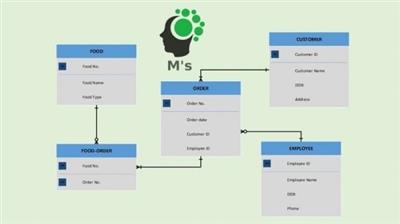Udemy - Database Design for Relational Databases using SQL Server
"softddl.org"
1-09-2021, 21:00
-
Share on social networks:
-
Download for free: Udemy -
-

MP4 | Video: h264, 1280x720 | Audio: AAC, 44.1 KHz
Language: English | Size: 1.76 GB | Duration: 5h 34m
What you'll learn

MP4 | Video: h264, 1280x720 | Audio: AAC, 44.1 KHz
Language: English | Size: 1.76 GB | Duration: 5h 34m
What you'll learn
Learn Best Practices for Relational Database Design
Understand Relational Theory
Learn the data normalization process
Understand the First, Second, Third and Fourth Normal Forms
Understand Boyce-Codd normal form
Identify relationship types between entities
How to enforce database relationships including one-to-one, one-to-many, and many-to-many
Learn functional dependencies
Learn multivalued dependencies
Learn what Update, Insert and Delete anomalies are
Surrogate keys vs Natural keys
Learn the difference Candidate keys and Super Keys
Learn how to implement physical design using SQL Server
Create database tables and alter existing tables
Create SQL Queries and Views
Requirements
A basic knowledge of computers
Description
Start learning Database Design Today!
A lot of IT professionals have a good working knowledge of SQL yet lack the foundational knowledge of relational database design. Learning database design and the relational model will put you ahead of the game. This course covers all the essential aspects of relational database design with practical demos given in SQL Server. You will learn how to spot un-normalized data structures and how to correct them. You will learn all about the process of data normalization and why it is important. This includes the various normal forms such as Boyce-Codd normal form and fourth normal form. This course also covers tips on how to identify relationships between entities and how to correctly model them in a relational database.
You will be able to understand advanced database design concepts with the aid of intuitive diagrams and practical examples. You will learn how to identify functional dependencies and transitive dependencies in your data. You will learn the different types of keys and when to use them. In addition, you will learn the different types of relationships such as one-to-one, one-to-many, many-to-many, and self-referencing relationships. More importantly, the end of the course you will know how to enforce these relationships by using integrity constraints.
Note that you will need either a Windows or Linux computer to install SQL Server.
Who this course is for:
Anyone who wants to learn Database Design
Students studying Relational Theory
Database Professionals
Anyone looking to get into a database role
Anyone looking to enhance their Data Science or Data Analytics career
Software Developers and Web Developers looking to enhance their careers
Homepage
https://www.udemy.com/course/database-design-for-relational-databases-using-sql-server/Buy Premium From My Links To Get Resumable Support,Max Speed & Support Me
https://hot4share.com/lvrdpekxae13/8r5vl.Database.Design.for.Relational.Databases.using.SQL.Server.part1.rar.html
https://hot4share.com/uwpatpgmh17i/8r5vl.Database.Design.for.Relational.Databases.using.SQL.Server.part2.rar.html

https://uploadgig.com/file/download/D8C34393a45f7C5C/8r5vl.Database.Design.for.Relational.Databases.using.SQL.Server.part1.rar
https://uploadgig.com/file/download/1D5781a31589a316/8r5vl.Database.Design.for.Relational.Databases.using.SQL.Server.part2.rar

https://rapidgator.net/file/f4672237104dff27fa33b649d3d0a52b/8r5vl.Database.Design.for.Relational.Databases.using.SQL.Server.part1.rar.html
https://rapidgator.net/file/5fcae7bc324c52e172c310c859459400/8r5vl.Database.Design.for.Relational.Databases.using.SQL.Server.part2.rar.html

http://nitro.download/view/0E8450C080B8F88/8r5vl.Database.Design.for.Relational.Databases.using.SQL.Server.part1.rar
http://nitro.download/view/338D6D45D63567C/8r5vl.Database.Design.for.Relational.Databases.using.SQL.Server.part2.rar
Links are Interchangeable - No Password - Single Extraction
The minimum comment length is 50 characters. comments are moderated




